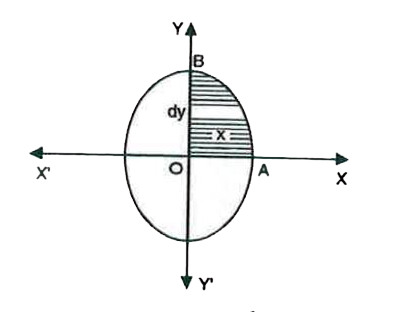Find the area of the region bounded by the ellipse x2a2+y2b2=1
To find the area of the region bounded by the ellipse given by the equation:
x2a2+y2b2=1
we can follow these steps:
Step 1: Understand the Geometry of the Ellipse
The ellipse is symmetric about both the x-axis and the y-axis. The points where the ellipse intersects the axes are:
- On the x-axis: (a, 0) and (-a, 0)
- On the y-axis: (0, b) and (0, -b)
Step 2: Divide the Area into Quadrants
Due to the symmetry of the ellipse, we can calculate the area in one quadrant and then multiply it by 4 to get the total area. We will focus on the first quadrant where x≥0 and y≥0.
Step 3: Set Up the Integral for Area in the First Quadrant
In the first quadrant, we can express y in terms of x using the ellipse equation. Rearranging the equation gives:
y=b√1−x2a2
The area A1 in the first quadrant can be calculated using the integral:
A1=∫a0ydx=∫a0b√1−x2a2dx
Step 4: Simplify the Integral
We can factor out the constant b:
A1=b∫a0√1−x2a2dx
Step 5: Use a Substitution
Let x=asin(θ), then dx=acos(θ)dθ. The limits change as follows:
- When x=0, θ=0
- When x=a, θ=π2
Substituting into the integral gives:
A1=b∫π20√1−sin2(θ)⋅acos(θ)dθ
Since √1−sin2(θ)=cos(θ), we have:
A1=b∫π20acos2(θ)dθ
Step 6: Evaluate the Integral
Using the identity cos2(θ)=1+cos(2θ)2:
A1=ab2∫π20(1+cos(2θ))dθ
Calculating the integral:
∫π201dθ=π2,∫π20cos(2θ)dθ=0
Thus:
A1=ab2⋅π2=πab4
Step 7: Calculate the Total Area
Since the total area A of the ellipse is four times the area of the first quadrant:
A=4A1=4⋅πab4=πab
Final Result
The area of the region bounded by the ellipse is:
πab
The ellipse is symmetric about both the x-axis and the y-axis. The points where the ellipse intersects the axes are:
- On the x-axis: (a, 0) and (-a, 0)
- On the y-axis: (0, b) and (0, -b)
Due to the symmetry of the ellipse, we can calculate the area in one quadrant and then multiply it by 4 to get the total area. We will focus on the first quadrant where x≥0 and y≥0.
In the first quadrant, we can express y in terms of x using the ellipse equation. Rearranging the equation gives:
We can factor out the constant b:
Let x=asin(θ), then dx=acos(θ)dθ. The limits change as follows:
- When x=0, θ=0
- When x=a, θ=π2
Using the identity cos2(θ)=1+cos(2θ)2:
Since the total area A of the ellipse is four times the area of the first quadrant:
The area of the region bounded by the ellipse is:
Similar Questions
Knowledge Check
Find the area of the region bounded by the ellipse x29+y24=1 in fourth quadrant.
A3π4 sq unitsB3π2 sq unitsC5π2 sq unitsDNone of theseThe area of the region bounded by the ellipse x225+y216=1 is
A20π sq unitsB20π2 sq unitsC16π2 sq unitsD25π sq unitsThe area of the region bounded by the ellipse x225+y216=1 is
A20π sq unitsB20π2 sq unitsC16π2 sq unitsD25π sq units
Find the area of the region bounded by the curves x=2y−y2 and y=2+x.
View SolutionFind the area of the region bounded by the ellipse :
(a)x29+y24=1
(b)(i)16x2+9y2=144
(ii) 4x2+25y2=1.
View SolutionFind the area of the smaller region bounded by the ellipse x2a2+y2b2=1and the line xa+yb=1
View SolutionFind the area of the region bounded by the ellipse x29+y24=1 in fourth quadrant.
View SolutionFind the area of the region bounded by the ellipse x24+y29=1.

View Solution
